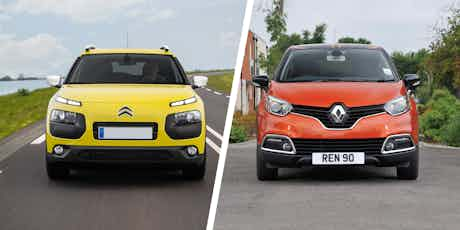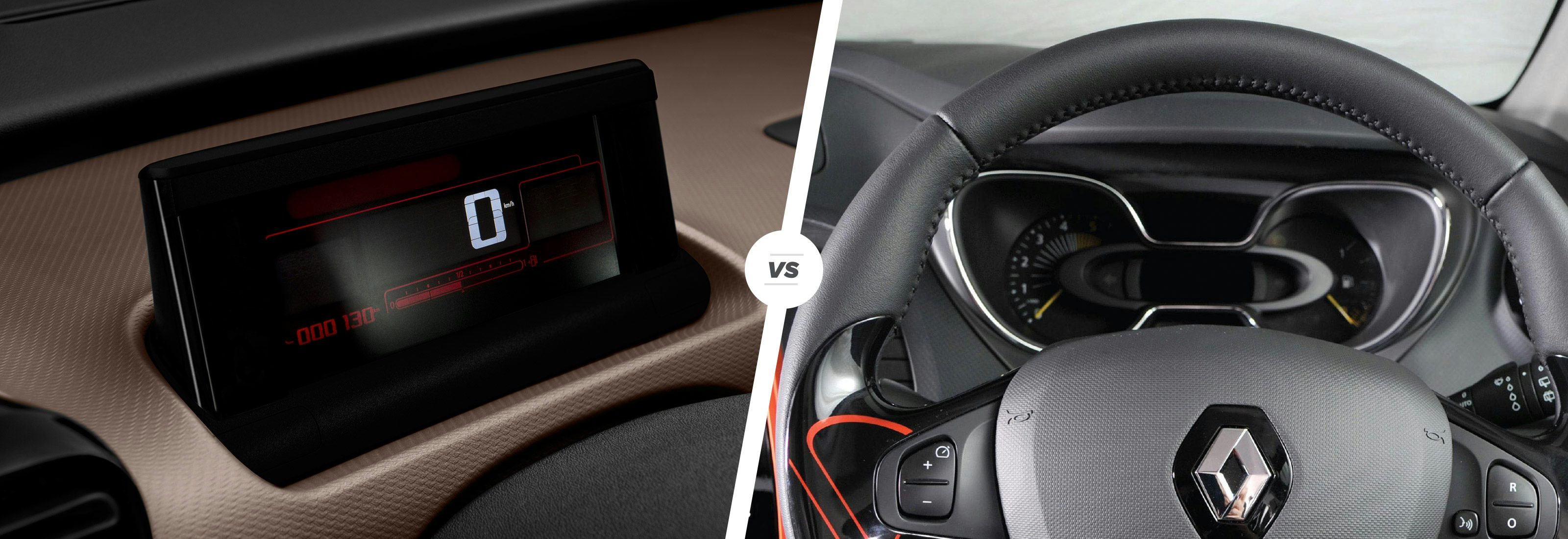Citroen Cactus vs Renault Captur: crossover clash
October 02, 2015 by carwow staff

At least from outward appearances, both the Citroen C4 Cactus and Renault Captur manage to attract more attention than most small crossovers. Both models are typically French – the Citroen is wonderfully eccentric, the Renault looks more subtle yet remains graceful.
If you’re in the market for a distinctive mini-SUV, which should you choose? We compare the pair side-by-side to find out. Taken by these cars? Put either the Citroen C4 Cactus or the Renault Captur in our car configurator to see how much carwow could help you save.
Styling

For those who grumble about modern car design in the belief that ‘all cars look the same,’ the Citroen C4 Cactus should come as a breath of fresh air.
The curvy shape is both complimented and contrasted by several striking details, most eye-catching of which are the squidgy ‘Airbumps’ along the flanks and the bumpers. These soft, deformable sections not only serve a practical purpose – they protect the paint from the sort of low speed impacts that occur in car parks – but they can be coloured in contrasting shades to the rest of the car. Other details like the narrow window line and slim headlights help to give a very contemporary look overall.
Although the Captur doesn’t quite offer the same visual drama, it remains one of the more classy designs in the compact crossover sector. The bold, almost oversized Renault family face dominates the front, while bright paint finishes with a range of alternative roof colour choices help it to look lively and youthful. Its sculpted bodywork is sure to appeal to those not taken by the chunky styling applied to many other crossovers.
Interior

Just like the outside, the Cactus’s cabin is interesting to look at and innovative to use. Traditional dials have been replaced with a digital display while, thanks to the large tablet PC-like central screen, the button count is very low, helping the dash to look clean and uncluttered. Other neat touches include a passenger airbag mounted in the roof which frees up additional storage space on the dashboard.
The Captur’s design is a little more traditional, but still pleasant to look at. Lots of piano black trim gives it a modern look (so long as it’s regularly wiped clean of grubby fingerprints) and, while some of the plastics feel a little cheap, the quality of the parts you touch feels high enough.
The Captur is the more roomy car, particularly in the back. The Citroen’s rear windows don’t wind down, either – in the name of keeping things simple, they hinge outwards instead. Both cars boast generous boots – the Cactus’s 358-litre load bay is impressive, but can’t match the Captur’s 377 litres, which can even expand to 455 litres if the rear bench is set into its forward-most position.
Driving

One of the advantages of crossover vehicles like the Captur and Cactus is that their raised ride heights allow for a softer suspension setup than traditional superminis, which in turn results in a smoother ride. As a result, both of these cars are commended by testers for their comfort. Typically for small cars, however, large bumps and potholes tend to jolt through the cabin. The raised height also gives a better view of the road ahead, increasing driver confidence.
The Renault’s steering is light and sharp, which helps to make it feel agile, though some suggest that a lack of feel makes it difficult to judge when the wheels lose grip. The Cactus benefits from a very low weight – most examples tip the scales at barely more than 1,000kg – though a rather slow-witted steering rack means it never feels quite as nimble as it perhaps should.
Engines

The Cactus’s low weight brings other benefits, too. The small, frugal petrol and diesel engines have very little to haul around, so performance is fairly sprightly, while fuel economy is even better. The modest 1.2-litre turbocharged petrols produce between 74 and 109hp, and all claim to deliver over 60mpg. The most frugal 1.6-litre diesel is capable of 83.1mpg, making it one of the most fuel-efficient cars on sale today.
Both units are fairly refined, though testers recommend avoiding the automatic gearbox – its design unquestionably aids efficiency but it’s jerky to use and more expensive to buy.
The Captur’s gearboxes are both an improvement over the Citroen’s, though fuel economy isn’t quite a match. The claimed 76.4mpg of the 1.5-litre turbodiesel isn’t to be sniffed at, however, and the unit itself is smooth and torquey. A pair of petrol engines feature, too: a tiny 0.9-litre turbo kicks out 89hp and should manage 56.5mpg, while a more potent 1.2 turbo produces 119hp and returns 52.3mpg. We’d avoid the former unless you’re planning on staying around town, it feels noticeably underpowered.
Value for money

The C4 Cactus manages to streak ahead of the Captur in the value stakes. While the basic Captur offers air conditioning and alloy wheels as standard – two features the entry-level Cactus lacks – the Citroen costs £1,300 less. Compare the two top-of-the-range petrol models, and that difference creeps up towards £3,000, yet the Cactus remains both cheaper to run and faster.
All Cactus models feature a seven-inch infotainment touchscreen, LED running lights and cruise control as standard, while top spec ‘Flair’ models get 17-inch alloy wheels and a reversing camera.
Both cars fall into very similar insurance groups, and both pump very little carbon dioxide from their exhaust pipes, helping to keep road tax costs low. Both have been crash tested by Euro NCAP, and the Renault came out on top with a maximum five-star rating. That isn’t to say the Cactus is unsafe, it was marked down for lacking an autonomous city braking system – a standard-fit feature for the Captur.
Verdict

Both cars rank very highly in the compact crossover class but, in a head-to-head contest, the Citroen wins it. Both are comfortable, fugal and stylish, but the Citroen’s tiny running costs, lower purchase price and added charm helps it win us over. It’s an opinion confirmed by the rest of the UK motoring press, too – based on our aggregated wowscores, the C4 Cactus outscores the Captur by 7.6 points to 7.2.
The Renault still has plenty to offer though. It’s more spacious than the Citroen, and it’s a little more fun to drive. The Citroen’s styling won’t be to everyone’s taste, either. If it was our money, though, we’d go for the quirky one every time.
Save money on your Citroen C4 Cactus or Renault Captur
Put either the Citroen C4 Cactus or the Renault Captur in our car configurator to see how much carwow could help you save. For more options, head over to our deals page or, if you’re still struggling to pick your next car, check out our car chooser.















